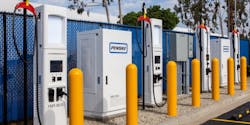Hitachi and Penske: The Electrified EV Fleet Future is "all Hands on Deck" to make it happen
So we’re told that electric vehicles and electrification of commercial fleets is almost a done deal. The momentum of the energy transition to electric vehicles and commercial fleet electrification is moving so fast that resistance is futile. It’s like a done deal.
Except it’s really not.
The move to electrifying the transportation sector, which accounts for about 29 percent of harmful greenhouse gas emissions in the U.S., is all about going the right direction but taking the drive with others and communicating all the way down the road.
Experts from Hitachi and Penske joined together this week to convey successes, lessons learned and future challenges to making the EV revolution happen for real. The two have partnered on existing predictive maintenance programs and are teaming for the future journey to electric fleets.
This is an important deal for Penske, in particular, which has a worldwide fleet of close to 330,000 medium and heavy trucks in the leasing world. This is a macro-transition in the biggest mac way possible.
“We can’t do it alone,” said Jonathan Gibson, who is executive vice president of marketing and business developing at Penske. “We need partners.”
Several Hitachi executives joined Gibson and Penske colleague Bill Combs in the webinar focused on how one of the world’s largest fleet owners will reach full and profitable EV transition. Penske already owns a sizable EV fleet and developed charging infrastructure, particular in California.
Participate in our Commercial Fleet EV Business Intelligence Survey
Hitachi’s primary role in its partnership has been focused around proactive diagnostics and guided repair. The former uses data and machine learning artificial intelligence (AI) to ascertain when repairs are needed so they are handled before any breakdown can happen.
Guided repair technology, created with Hitachi, works to improve the accuracy of maintenance. This is predicting exactly what needs to be fixed, as evidenced by more than 64,000 service opportunities last year.
Understanding driving patterns and vehicle wear have always been important, but the nuances of that data will gain more intense relevance in the electrified fleet future.
“Up time is paramount for those vehicles,” noted Combs, who is vice president of sustainability at Penske.
The next-gen journey Penske and Hitachi are taking together is mapped to tackle the EV challenge. Some of the worries are around well-known problems such as range fear and frequency of charging infrastructure, but scaling up solutions to succeed isn’t as simple as one might think.
Hitachi is developing technology to better connect direct current systems to fit into parking areas and connect to the grid. This type of crowded situation—hemmed in on all sides by buildings, streets and other vehicles—calls for dialogue and collaboration, leaders with both companies said.
“It requires a much more holistic approach,” Hicham Abdessamad, chairman and CEO of Hitachi America, said. “It’s about building the right relationship with utility customers, having charging stations...optimizing routes.”
Communication with the power generators and delivery firms, electric utilities, is key. Fleet owners and drivers will learn just how much better the EV option is, they say, but it all begins with the utility.
“We start right away by planning,” Combs said. “We need to go to utilities not just beg them for electricity, but talk to them and help them to plan.
“The end point is utilities,” he added. “Think of it as bandwidth from the internet.”
The EV revolution is a huge scaling issue, it was said. The current one-on-one method of charging stations will not work in a future of massive trucks needing juice to run their routes and go long distances.
It will require companies making the jump to EVs, while working closely with infrastructure providers, automakers, utilities and retailers, among others.
“It’s all hands on deck,” Combs said.
-- -- -- -- --
If you are an electric utility pro who has some knowledge of the challenges and progress to CEV adoption, we invite you to complete our short survey. Just click here to get started. In addition, we’ll enter you into a drawing to win a $100 Amazon gift card or a free registration to our inaugural event, T&D World Conference and Exhibition, being held in Charlotte, NC, Oct. 5-7, 2022.
About the Author
Rod Walton, EnergyTech Managing Editor
Managing Editor
For EnergyTech editorial inquiries, please contact Managing Editor Rod Walton at [email protected].
Rod Walton has spent 17 years covering the energy industry as a newspaper and trade journalist. He formerly was energy writer and business editor at the Tulsa World. Later, he spent six years covering the electricity power sector for Pennwell and Clarion Events. He joined Endeavor and EnergyTech in November 2021.
Walton earned his Bachelors degree in journalism from the University of Oklahoma. His career stops include the Moore American, Bartlesville Examiner-Enterprise, Wagoner Tribune and Tulsa World.
EnergyTech is focused on the mission critical and large-scale energy users and their sustainability and resiliency goals. These include the commercial and industrial sectors, as well as the military, universities, data centers and microgrids. The C&I sectors together account for close to 30 percent of greenhouse gas emissions in the U.S.
He was named Managing Editor for Microgrid Knowledge and EnergyTech starting July 1, 2023
Many large-scale energy users such as Fortune 500 companies, and mission-critical users such as military bases, universities, healthcare facilities, public safety and data centers, shifting their energy priorities to reach net-zero carbon goals within the coming decades. These include plans for renewable energy power purchase agreements, but also on-site resiliency projects such as microgrids, combined heat and power, rooftop solar, energy storage, digitalization and building efficiency upgrades.

